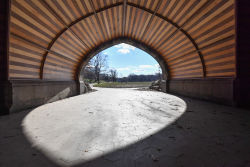Prospect Park
View all monuments in NYC Parks, as well as temporary public art installations on our NYC Public Art Map and Guide.
Ludwig Van Beethoven
| Artist: | Henry Baerer |
| Dedicated: | October 20, 1894 |
| Location: | Flower Garden |
Artwork History
This bronze bust of the world renowned German composer Ludwig van Beethoven (1770–1827) was created by the German-American sculptor Henry Baerer (1837–1908). Dedicated in 1894 in the Prospect Park Concert Grove, the statue is one of seven in the immediate vicinity which include Wolfgang Amadeus Mozart, Karl Maria Von Weber, Edward Grieg, Washington Irving, Abraham Lincoln, and Thomas Moore.
Beethoven was born in Bonn, Germany, and studied with his father, who was a singer in the electoral choir. Demonstrating early talent as a pianist, he studied with a succession of instructors, including stints with Wolfgang Amadeus Mozart (1756–1791) and Franz Joseph Haydn (1732–1809). He made his public piano debut in 1800, but growing deafness curtailed his public performances.
Beethoven’s hearing disability did not undermine his prodigious talent as a composer. His early works in the 1800s included piano sonatas and chamber music. Recognized as a genius in virtually all musical forms, he is perhaps best known for his extraordinary symphonic output, especially his Fifth Symphony (1805-1807) and his Ninth Symphony (1817-1823). Though a staunch classicist, his music served to usher in the Romantic era.
The original plan for Prospect Park, designed by Frederick Law Olmsted and Calvert Vaux in 1866, left blank this area of the park, except for the written labels “Concourse for Pedestrians” and “Music Stand.” With the park under construction around 1870, Olmsted and Vaux elaborated their design to accommodate musical performances. Within an otherwise pastoral park, they set formal grounds with terraces and a radial arrangement of walkways, punctuated by lineally arranged trees, lavish floral beds and elaborate decorative carvings in New Brunswick sandstone. Noting that, “Promenade concerts are common in many European pleasure grounds [and were] universal in German towns, common in French, and less so in British,” they sought in the concert grove to achieve a place with this purpose in mind.
At the north end was built the Concert Grove House, demolished in 1949, and at the south end Vaux designed the Concert Grove Pavilion, completed in 1874. Made of eight cast-iron posts modeled after Hindu columns of the medieval period (8th to 12th centuries), and supporting an elaborately painted hipped roof with stained-glass cupola, the structure, restored in 1987, is also known as the Oriental Pavilion. At one time it was used as an open-air restaurant.
In 1887, the Music Pagoda was built near the Lily Pond, and with the subsequent establishment of a new music grove at the north edge of the area of the park known as the Nethermead, this area came to be referred to as the Flower Garden.
The Concert Grove possesses a rich collection of bronze sculptural portraits. Three of which—Augustus Mueller’s Wolfgang Amadeus Mozart (1897), Chester Beach’s Carl Maria Von Weber (1909), and this statue—were donated to the City of Brooklyn in 1894 by the United German Singers of Brooklyn. The group had won the busts as trophies at the 17th National Saengerfest (singing festival), a choral competition held in Madison Square. At a cost of $2,000, the group commissioned the pedestal, and had the monument installed in the Concert Grove.
Sculptor Henry Baerer was born in Kirscheim, Germany, and came to the United States in 1854. He was especially well-known as a portrait sculptor, and contributed six sculptures to the parks of New York City, including statues of General Gouverneur Kemble Warren in Grand Army Plaza, Brooklyn, an earlier version of Beethoven in Central Park, and a bust of industrialist Conrad Poppenhusen in College Point, Queens.
In 1997, the sculpture bust was conserved by the City Parks Foundation Monuments Conservation program, with funding from the Florence Gould Foundation. Further funds are sought to recreate the decorative bronze wreath and lyre that once adorned the front of the pedestal.
Artwork Details
| Description: | Bust on pedestal |
| Materials: | Bronze, white granite |
| Dimensions: | Bust H: 4'; Pedestal H: 9'6" W: 4' D: 3' |
| Foundry: | Lorne & Aylry, New York (1894 ) |
| Donor: | United Singers of Brooklyn |
Inscription
BEETHOVEN / PRESENTED TO THE / CITY OF BROOKLYN / BY THE UNITED GERMAN SINGERS / OF THE CITY. / FIRST PRIZE AT THE / 17TH NATIONAL SAENGERFEST, / HELD AT NEW YORK JUNE 22 - 26. /Please note, the NAME field includes a primary designation as well as alternate namingsoften in common or popular usage. The DEDICATED field refers to the most recent dedication, most often, butnot necessarily the original dedication date. If the monument did not have a formal dedication, the yearlisted reflects the date of installation.
For more information, please contact Art & Antiquities at (212) 360-8163.
Check out your park's Vital Signs
Clean & Safe
Green & Resilient
Empowered & Engaged Users
Share your feedback or learn more about how this park is part of a
Vital Park System












